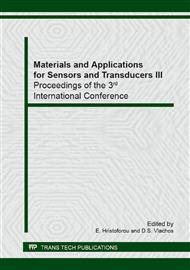p.645
p.649
p.653
p.657
p.661
p.665
p.669
p.673
p.677
Chronoamperometry Study of the Electrodeposited Ni100-XPx Alloy Thin Films
Abstract:
Elecrodeposited Ni-P alloy thin films have been the subject of extended investigations, since the pioneering works of Brenner et al, in the late 1940s. It is well known, that the physical and chemical properties of the Ni-P deposit composition are strongly influenced by the preparation conditions. In our experimental procedure, we have used a Parstat 2253 potensiostat equipped with Power-Suite software. All the electrochemical experiments were performed in a three electrode cell in which the volume of the bath was 150ml, in this experimental technique, we can measure one or more of three parameters: the potential (V), current (i), and time (t). The aim of our work consists to study the nucleation and growth process and given morphology and composition of electrodeposited Nix-P100-x thin films on Copper substrates. For this purpose, cyclic voltametry and chnonoamperomaty have been used in order to determine the previous cited properties of thin films Ni-P, [0.10 of NaPH2O2 solutions. The chrnoamperogramms can be interpreted by the use of one of three models called: Growth mode (Me layer by layer formation); Franck Van der Merwe, FM model, Growth mode 3D (Me island formation on the top of predeposited), 2D Meads overlayers on substrat and Stranski-Krastanov; (SK model).
Info:
Periodical:
Pages:
661-664
Citation:
Online since:
April 2014
Authors:
Price:
Сopyright:
© 2014 Trans Tech Publications Ltd. All Rights Reserved
Share:
Citation:


